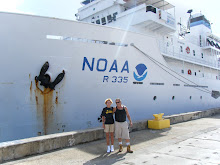

Left: Jeff & Jonathan prepare the CTD
Right: Retrieving the CTD (check the feet)
All day Friday, all night, and into Saturday has been spent with the multibeam sonar collecting data and mapping the area of study. The “fish people” need an idea of the bottom contours to decide where to put the cameras. Yesterday afternoon, the scientists used a CTD tool to measure conductivity, temperature and density. The results of this test were used by the map makers to most effectively use the sonar data for accurate maps. Currently the camera crew is preparing to launch 5 sets of cameras. The BotCam (bottom camera bait station) has an anchor and floatation that will keep it a few feet above the bottom. The BRUVs (Baited Remote Underwater Video) will sit directly on the bottom. We should have fish data later tonight but, 10 cameras will make a lot of video to watch.



No comments:
Post a Comment